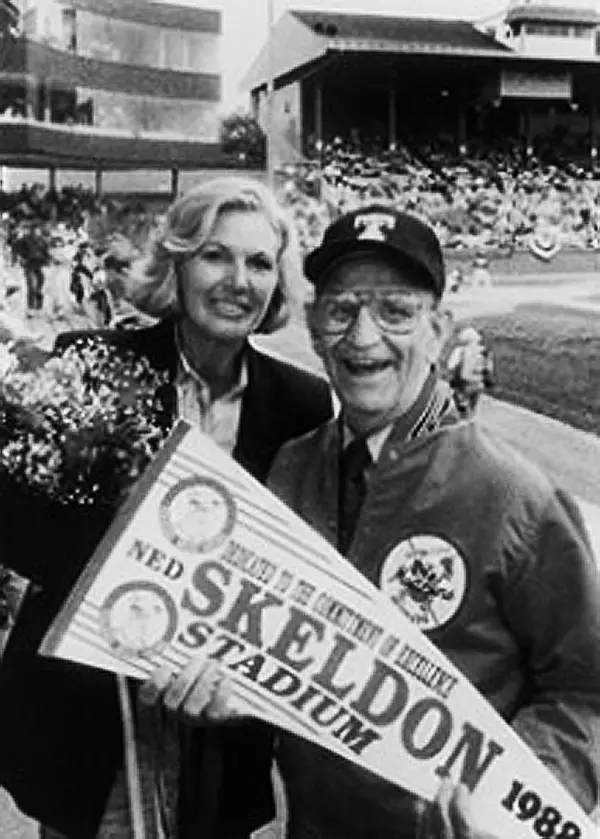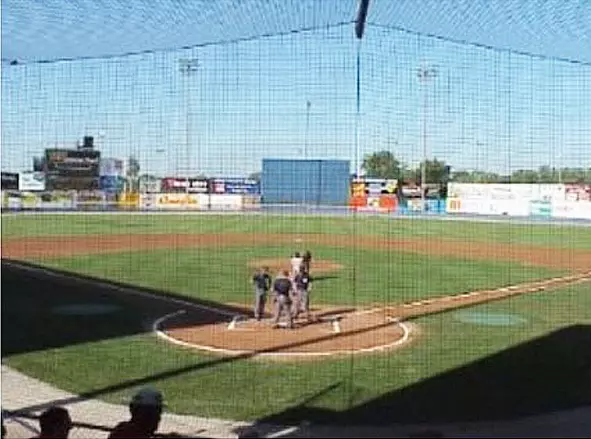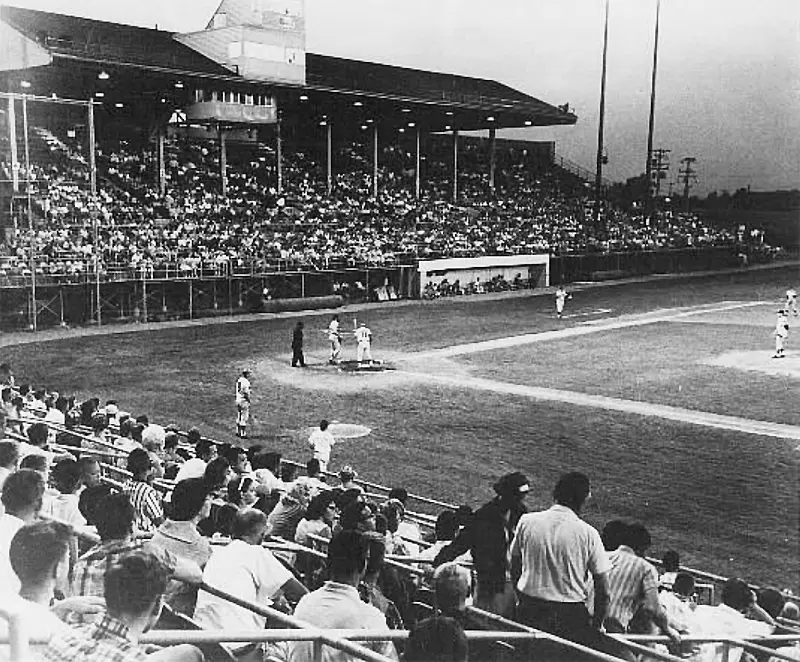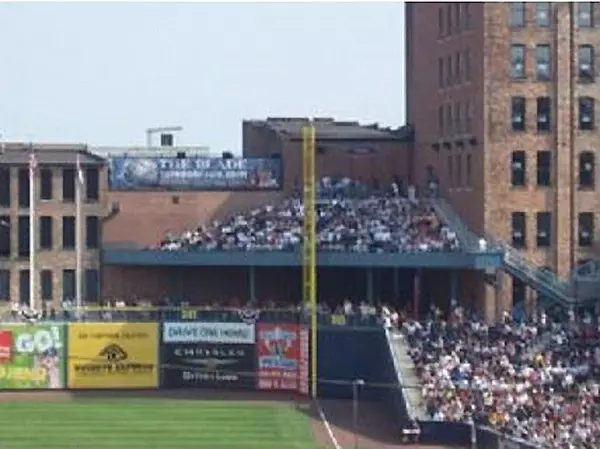Baseball Leaves Toledo Twice, 1950-1956
The Mud Hens were now owned by the Tigers, but this failed to help the team put a winning outfit on the field. In the three years of the Tigers reign, the team failed to post a winning season and drew only 300,000 fans total.
Danny Menendez purchased the team from the Tigers in 1952 and tried to raise interest for the team within the city of Toledo. An offer to purchase the club came to Menendez from a group in Charleston, WV, and Menendez quickly decided to move the team out of Toledo. This move was fought by members of the Toledo community, and Menendez settled for leaving the team’s offices in Toledo while having the team play its home games in Charleston in 1952.
The City of Toledo would not go without a team for long as the Milwaukee Brewers minor league franchise, now displaced due to the arrival of the Braves from Boston, settled on Toledo as their new home. The new franchise would assume the name Glas Sox, eventually shortened to Sox.
The new Sox were a far more exciting than the Mud Hens team that relocated to Charleston. Players such as Negro and American League veteran Sam Jethroe would lead the team to a first place finish in 1953. The team would just miss playing in the Junior World Series that year, losing to the Kansas City franchise in seven games. The 1953 season would prove to be an anomaly, as the team quickly returned to its losing ways, finishing in 5th and 6th place the next two seasons. Attendance quickly sagged as well. Three years into operating a team in Toledo, the Brewers quickly departed, leaving the city without a franchise. Sensing that a new franchise was not coming soon, the city quickly demolished the aging Swayne Field, replacing the historic stadium with a strip mall. 1957 saw Toledo without a baseball team or a baseball stadium.
Notable players: Gene Conley, Bill Klaus, Sam Jethroe.
Mud Hens Return 1965-1973
With the beginning of the 1965 season, Ned Skeldon's dream of bringing baseball back to Northwest Ohio had been accomplished. Although the team did not play within the boundaries of the city of Toledo, it was given the name the Toledo Mud Hens and was now the Triple A affiliate of the New York Yankees.
After two respectable – but sub-.500 – seasons, the Tigers and Yankees switched farm teams and Toledo was now able to watch the young prospects of the Tigers play in Toledo. Former manager Jack Tighe returned to manage the team and it quickly showed improvement, finishing in third place and qualifying for the playoffs in 1967. That year would bring the Mud Hens their first championship in 40 years, as they defeated Columbus to win the Governors Cup championship. The next season, the team finished the regular season in first place, but failed to repeat as champions. All of these successes seemed to be lost on the Toledo fans, as the team finished consistently toward the bottom in attendance in the International League.
The next five years failed to bring success either on the field or off. The Toledo fans still stayed away from the ball club they wished would return, consistently finishing in the bottom third in attendance. The team on the field did not fare any better: the Mud Hens were only able to muster one winning season during this stint as a Tigers affiliate. Although several Tigers players would make their way through Toledo during this time period, the Tigers severed ties with the team in 1973.
Notable players: Ike Brown, Mike Marshall, Joe Niekro, Jim Rooker.
Ned Skeldon
For nine years, Toledo was without a minor league baseball franchise, the longest such period in the then-seventy year history of Toledo baseball. One man was determined to end that drought as soon as possible: Edward J. "Ned" Skeldon.
Ned Skeldon was a longtime advocate for Toledo and Northwest Ohio. A lifelong resident of the area (save military service and working for Toledo interests in Washington D.C.), Skeldon entered local politics by winning the Vice Mayor position, and later served four terms as the County Commissioner. Skeldon also fought to clean up the Maumee Valley, heading the Clear Water, Inc. and serving as Vice Chair of Ohio Water Development Authority, groups advocating environmental cleanup of the Maumee River and Northwest Ohio.
In the early 1960s, Skeldon proposed that the racetrack at the county fairgrounds be converted into a baseball park, and set out to build a committee that would help him to accomplish it. The committee that was created to bring baseball back to Toledo was made up of area businessmen and civic leaders. The group included Henry Morse of Toledo Trust (President), Steve Stranahan (Vice President), Monsignor Jerome Schmit of St. Patrick's Church (Secretary-Treasurer), and Ray Johnston (General Manager).
After the reconstruction of the park, Skeldon was able to bring the Triple A franchise from Richmond, VA to Toledo, along with an affiliation with the New York Yankees.
Toledo was given another shot at minor league baseball – resuscitating the Mud Hens moniker – and fielded a team for the 1965 International League season at the (sort of) new Lucas County Stadium.
Skeldon would continue to have a working relationship with the team. The stadium was eventually renamed for Skeldon in 1988, in honor of his legacy. He died just three months after the stadium’s dedication.
Mediocrity and Various Affiliations, 1974-1987
After the Tigers left Toledo once again in 1973, the Philadelphia Phillies came to town bringing their Triple A prospects. Even with the infusion of new blood, and Hall of Fame pitcher Jim Bunning as manager, the team still remained in the cellar of the International League. Attendance increased slightly (most likely due to Bunning), but the team still drew far less than the rest of the league.
The Phillies would leave after just two years of affiliation, and the Indians soon came to town. This would seem to be a perfect marriage, bringing one of the in-state teams' minor league affiliates to Toledo. But once again, the fans failed to show up; the team played poorly on the field; and the Indians were gone after two cellar-dwelling seasons.
The Twins and Cal Ermer became the new affiliate for the Mud Hens in 1978 and brought some stability and excitement to the franchise. Ermer, a former manager for the Major League franchise, would stay at the helm of the Mud Hens for eight years, a record for tenure with the team. Another key addition was Gene Cook, who served the Mud Hens in the front office for nearly two decades.
The team started out well, advancing to the playoffs in 1978 for the first time in a decade. In 1979, the team regressed slightly, but quickly returned to the playoffs in 1980, eventually losing in the Governors Cup final to Columbus. The team would continue to be inconsistent, following up decent seasons with finishes in the cellar of the International League.
Although the Mud Hens were inconsistent, the team began to draw more fans. The 1978 season saw the team top their 1965 attendance for the first time. During the rest of the Twins years, the team continued to stay at or near this number, even topping 200,000 during their playoff season.
The 1982-1986 Mud Hens teams featured many of the stars of the two World Champion Minnesota Twins teams: Kirby Puckett, Frank Viola, Tim Tuefel, Greg Gagne, Randy Bush, and Steve Lombardozzi. Puckett and Tuefel would finish third and fourth for the 1984 Rookie of Year. The teams also featured future Texas Rangers manager Ron Washington and Oakland Athletics General Manager Billy Beane.
Cal Ermer left the Mud Hens before the 1986 season, being replaced by future Major League manager Charlie Manuel. After years eight years of inconsistent play, the Twins would soon follow Ermer out of Toledo, severing their affiliation with Toledo following the 1986 season. This move set the stage for the return of the Tigers, who have continued their relationship with the Mud Hens to this day (2007).
Notable players/managers: Jim Bunning, Dave Engle, Cal Ermer, Greg Gagne, Ron Hassey, Joe Lis, Charlie Manuel, Kirby Puckett, Tim Tuefel, Frank Viola, Gary Ward, Greg "Boomer" Wells, Tack Wilson.
Tigers Return to Toledo, 1987-2002
The 1987 season was a homecoming in many ways for the Mud Hens. First and foremost, the Detroit Tigers and their Triple A players returned to Toledo in 1987, a marriage that continues today. Along with the return of the Tigers came a return of the fans to Mud Hens games, with even the worst Mud Hens teams still drawing more than 168,000 fans, and in most years well over 200 and 300 hundred thousand. In another homecoming, broadcaster Frank Gilhooley returned to the team to broadcast games with partner Jim Weber.
In 1987, the team began a streak of last or nearly last place finishes that would not end until 2002. Despite these consistently poor teams, fans continued to come out to the Lucas County/Ned Skeldon Stadium, averaging nearly 300,000 people during this losing streak. On June 28, 1988, the team honored long time friend Ned Skeldon by changing the name of the stadium to Ned Skeldon Stadium. Unfortunately, Skeldon would not get to see his beloved Mud Hens make it to the playoffs again, passing away three months after the dedication ceremony.
The International League continued grow in popularity and in 1998, expanded to 14 teams (up from 10). This expansion moved the Mud Hens into a four-team division with Columbus, Louisville, and Indianapolis, all three top teams of the International League. This move further cemented the Mud Hens into the cellar of their division for the immediate future. The stability of the Twins/Cal Ermer years was also lost. The Mud Hens went through a manager every other season, with the longest tenure, that of Joe Sparks, lasting only three seasons. Other managers who led the Mud Hens included John Wockenfuss, Tom Runnels, Leon Roberts, Pat Corrales, and Larry Parish (first of two stints as manager).
By the end of the 1990s, Ned Skeldon Stadium was beginning to show its age. What was once a quirky stadium was now becoming run down, some equating it to a high school facility. This was not lost on the city of Toledo, which had yearned to bring the Mud Hens back within the borders of the city and into a modern stadium.
Notable Players and Managers: Frank Catalanatto, Pat Corrales, Travis Fryman, Tom Gamboa, Phil Hiatt, Jose Lima, Larry Parrish, Bubba Trammell.
The Future of the Mud Hens, 2002-Present
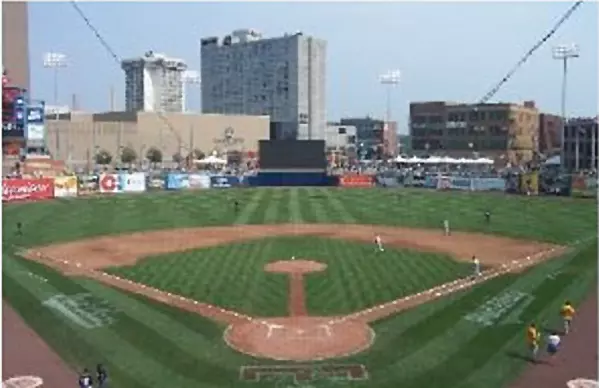 Fifth Third Field, the new home of the Mud Hens in 2002
Fifth Third Field, the new home of the Mud Hens in 2002
In 2002, the Mud Hens moved into Fifth Third Field, a custom stadium designed for baseball use in downtown Toledo. The new stadium, patterned along the new trend of "retro" stadiums, was built into the side of one of the existing downtown buildings, purposely lower than street level. This allows for views inside the stadium from outside its walls.
The Mud Hens were an instant success in their new home, winning the Western Division in their first year at Fifth Third Field. After two years of mediocre play (which coincided with the rejuvenation of the senior Tigers ballclub), the Mud Hens returned to their winning ways in 2005 and 2006, winning the Governors Cup in both seasons. The attendance problems, like the years of losing, also seem to be a thing of the past. In their first five seasons at Fifth Third Field, the Mud Hens drew no fewer than 500,000 fans, almost 200,000 more than they drew annually in the comparably sized Skeldon Stadium. In 2007, the "Roost" section of Fifth Third Field was voted by ESPN as having the best seats in all of minor league baseball.
With the parent ballclub, under General Manager Dave Dombrowski, having more success in the various Major League drafts, the future of the Mud Hens looks bright.

